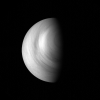Emily Lakdawalla • Sep 25, 2008
Doug Ellison at Europlanet 2008: Monitoring Venus with the VMC
Whilst out at the red planet, the European Space Operations Centre (ESOC) has recently turned the Mars Express Visual Monitoring Camera back on, at Venus, another VMC -- this time the acronym stands for Venus Monitoring Camera -- has been keeping four eyes on Venus.
Dmitri Titov talked about the VMC, a small, 1.25-kilogram (2.76-pound) instrument that projects four images onto one CCD. Each image is filtered separately, producing ultraviolet (367 nanometers), visible (520 nanometers), and two infrared images (970 and 1000 nanometers). Onboard electronics pull out the desired quadrants of the image from the CCD and send only those parts back to Earth. As Venus Express tours in its elliptical orbit, VMC can image the entire planet within a single frame from its farthest reach (referred to as apocentre, 66,000 kilometers from Venus' center). Venus fills the frame by the time Venus Express is halfway in. And VMC achieves a highest resolution of 200 meters per pixel at pericentre (closest approach). Exposures can range from less than half a millisecond for daylight imaging, to half a minute for night-side imaging in the infrared.
Before flight they were confident that direct solar illumination of the camera would not be a problem. However, Titov showed that some of their first light images were utterly ruined -- they looked like a picture of a brain instead of a planet. Fortunately, they were able to develop new flatfield techniques that now produce beautiful pictures of Venus.
VMC has seen some quite dramatic changes, especially in the ultaviolet filter, of clouds. Clouds are smooth and elegant in the morning, but as they pass the sub-solar point, they tend to become turbulent and chaotic. Equatorial clouds are often quite mottled, perhaps a symptom of sulphuric acid droplets forming.
In the polar regions, sometimes they see spiral arms, and sometimes the poles are crossed by dark streaks. They don't know what the origin of these is yet. They're just focused on making sure they just get lots of good images!
They've used the VMC to look at the limb of Venus, but have not seen much in the way of detached layers such as we might see at Mars or Titan. By using another of Venus Express' instruments, VIRTIS, to examine minute slices of the electromagnetic spectrum that cross into wavelengths where carbon dioxide selectively absorbs light, they can produce elevation maps of the clouds and have seen them range from about 73 kilometers high in equatorial regions, to 65 kilometers nearer the poles. [By comparison, Earth's highest visible clouds are about 12 kilometers above the ground. --ESL]
There is plenty to be seen in the ultraviolet imagery. While there is less detail immediately apparent with the visible and infared bands (contrast in visible and infrared images is only two to four percent, rather than 20 to 30 percent as for the ultraviolet images) they are still useful. Dimitri did mention, however, that they are looking for anyone who can help them process their data. I showed him Emily's preliminary work in producing one of her great PDS-to-public web pages and he was very pleased by it. I'm hoping that the talent of some of the people at unmannedspaceflight.com and elsewhere will be able to help the VMC team turn great pictures into great science!!!

ESA / MPS, Katlenburg-Lindau, Germany; animation by Emily Lakdawalla
Approaching Venus
A quick view of part of a Venus Express orbit, captured through the Venus Monitoring Camera (VMC)'s ultraviolet channel. The images were taken about an hour apart as the spacecraft approached Venus. Venus Express' orbit is polar and highly elliptical, with its closest approach near the north pole, so it spends a great deal of time over the south pole.Support our core enterprises
Your support powers our mission to explore worlds, find life, and defend Earth. You make all the difference when you make a gift. Give today!
Donate

 Explore Worlds
Explore Worlds Find Life
Find Life Defend Earth
Defend Earth

